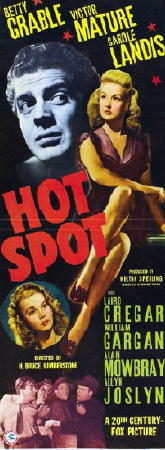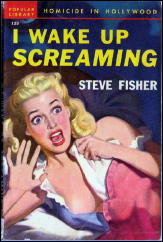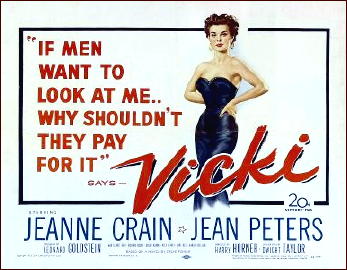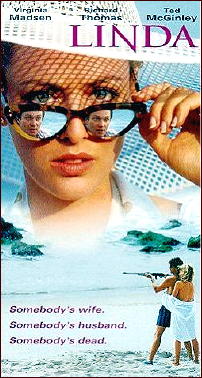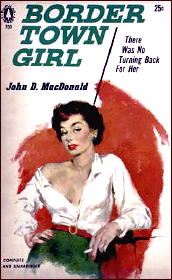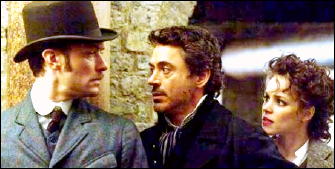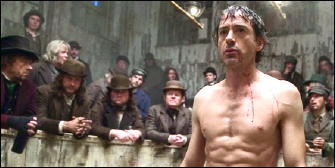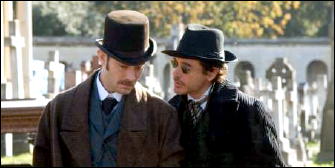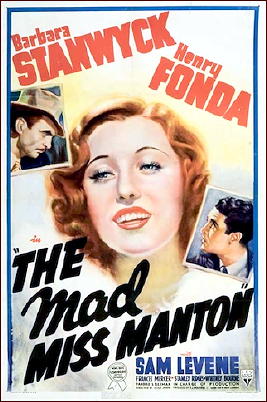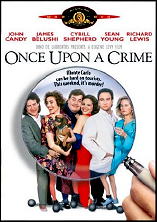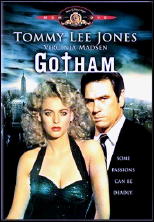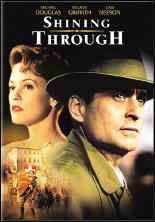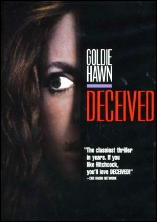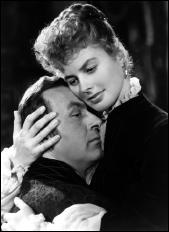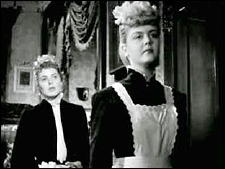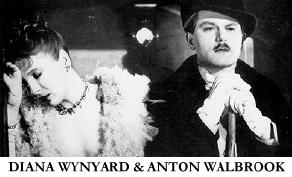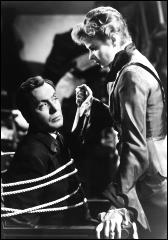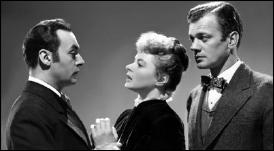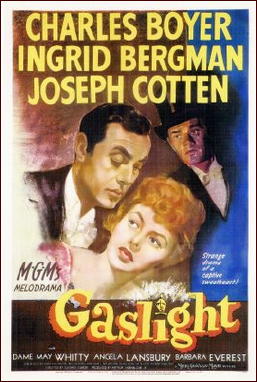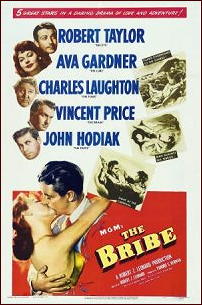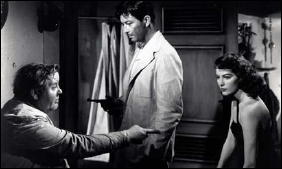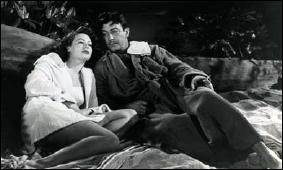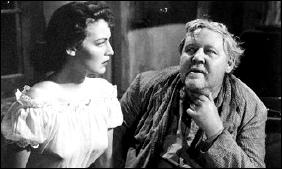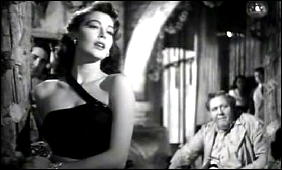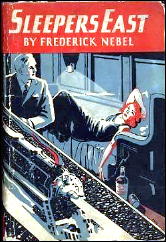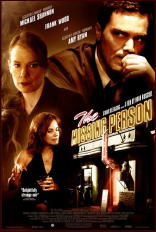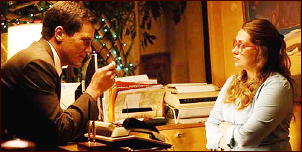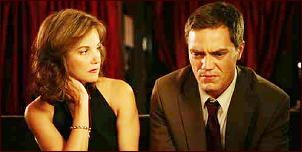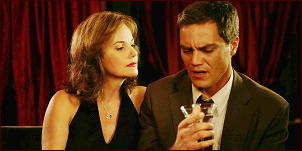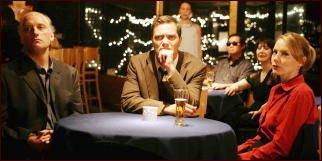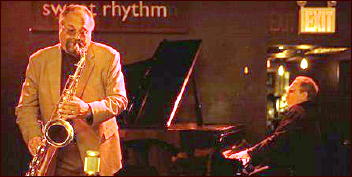Reviewed by DAVID L. VINEYARD:
THE MAD MISS MANTON. RKO Radio Pictures, 1938. Barbara Stanwyck, Henry Fonda, Sam Levine, Frances Mercer, Stanley Ridges, Whitney Bourne, Ann Lester, Catherine O’Quinn, Linda Terry, Hattie McDaniel, James Burke, Paul Guilfoyle, Penny Singleton, Grady Sutton. Screenplay by Philip G. Epstein, based on a story by Wilson Collison. Directed by Leigh Jason.
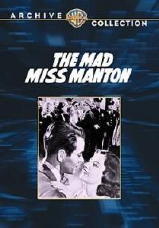
Melsa Manton (Barbara Stanwyck) is one in a long line of screwball heiresses who marched blithely though films of the nineteen-thirties and manage to hang on in one guise or another in films today.
Frank Capra’s It Happened One Night (1934) started the vogue (before that rich heiresses had tended to be more predatory than zany), and here the genre gets a kick from another film that debuted the same year as It Happened One Night, The Thin Man.
By 1938 RKO had already given us the definitive screwball heiress comedy in Katherine Hepburn in Howard Hawks Bringing Up Baby. The Mad Miss Manton isn’t quite in that class, but it is a fine mix of screwball comedy and comedy mystery played by an outstanding cast and with the kind of bright brittle and sparkling wit we can only regret real life heiresses and their entourage seldom display (hard to imagine Paris Hilton as Melsa Manton).
As the film opens Melsa has left a costume party early and arrives home still in her Bo Peep costume to walk her six yapping Pomeranians before bedtime, but when she spies a man leaving the deserted Lane mansion and the dogs start acting strange she goes inside and finds a body, so she summons the police.
Arriving on scene to find himself confronted by Bo Peep is Lt. Brent, Sam Levine, a character actor who made a career of sane exasperated cops plagued by the likes of Melsa Manton and Nick and Nora Charles. He’s dubious to begin with, and when no body can be found and he learns who Melsa is:
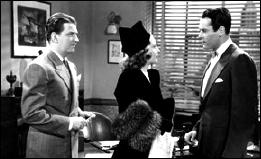
Brent: Oh — Melsa Manton, eh? Aren’t you one of the bunch who held the treasure hunt last week and stole a traffic signal?
Melsa: Yes, but it was a treasure hunt for charity. We run a T.B. clinic.
Brent: And aren’t you the dame who got an ambulance from Bellevue because one of your dogs had distemper?
Melsa: Well, he was very sick and the veterinarian was out of town.
It’s that kind of logic that gives cops ulcers. Which is why Lt. Brent is always sending someone out for a bicarbonate of soda.
To add insult to injury, newspaper editor Peter Ames (Henry Fonda) has begun a crusade against Melsa in his column in his newspaper, the latest installment of which brings Melsa storming in to sue him and slug him — and get slugged in return.
Peter: I’m sorry, miss. I don’t as a rule go around slugging women, at least not as much as I’d like to. It was pure reflex — self preservation and all that.
But as these things go, first they fight and then they romance, and one look at Melsa in the flesh is enough for Peter Ames, especially since he now has to convince her not to sue the paper for a million dollars just in case a corpse does show up and her wild tale proves true.
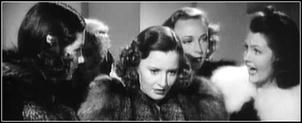
Meanwhile Melsa summons her posse of rich girl friends, a bevy of silver fox clad beauties all as mad as Miss Manton for a war conference in her apartment to the bemusement of her maid, Hilda (Hattie McDaniel), especially when the killer returns the cloak Melsa lost at the murder scene with a knife and a threat penned to it.
Hilda: Dat knife ain’t for openin’ lettahs. You look heah — you-all stay home and don’t go messin’ ’round in things what ain’t none of yo’ business. If somebody wants to go ’round murderin’ folks, t’ain’t none of yo’ concern.
Racist, probably, and certainly stereotyped, but somehow I always found Miss McDaniel, Mantan Moreland, Stepin Fechit, and Willie Best the only sane voice of reason in this sort of film, or as Hattie’s Hilda adds: “You white folks don’ know what’s good for you.”
Good advice, but you can be sure Melsa and her pals aren’t going to listen to it anymore than Brent or Peter will listen to her when she and her pals find playboy Ronnie Belden in his own refrigerator with a knife in his chest. When Brent tells her to keep the body on ice, believing she and her friends are up to their old tricks, they take the body and plant it in the lobby of Peter’s newspaper.
That’ll teach him.

So Brent rounds the girls up and arrests them, only Peter calls Melsa’s father:
Melsa: Who told you we were in jail?
Popsie: Chap called Ames — Peter Ames.
Helen (Frances Mercer): That’s a surprise! That’s light creeping in! After all when a man calls Melsa “Melsa.”
Kit (Vicki Lester): Psychologists say that hate is only a few steps away from love.
Myra (Linda Terry) It’s the lull in between that drives you crazy!
But with a real body involved, Brent and Peter both have to take Melsa and her friends more seriously, but can’t convince them this isn’t a game. But Peter is drawn in and even ends up hiring a safecracker to help him investigate when the girls show up as he is about to check out a suspects office:
Peter: Still — we’re all here for the same purpose. I brought in Mr. —
Safecracker: No names, boss, no names!
Helen: Are you a real crook?
Safecracker (Olin Howard): The last lawyer that defended me said I was anti-social. I kind of like that better than crook.
Peter: All right, Mr.X, let’s go to work.
Safecracker: Naw, not in front of witnesses.
Peter: She’s (Melsa) all right; she’s the girl I’m going to marry. You know, a wife can’t testify against her husband.
Safecracker: Yeah, but she could testify against me.
Melsa: I could marry you. As a matter of fact I’d prefer it.
Safecracker: Looks like she isn’t going to marry you.
Melsa: Why yes, I am going to marry him.
Safecracker: What about the other dame?
Helen: I’m going to be his second wife.
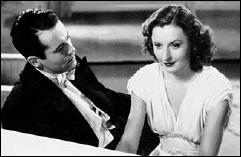
And so it goes, bright and brittle dialogue, a pretty good mystery, and a well done solution that ends with a royal melee in which the ladies are as much a hindrance as a help.
Brent stops the killer and a bullet, but as Peter and Melsa bend over him to bring him to their eyes meet and:
Peter: Darling!
Melsa: Darling!
Peter: Let’s get married soon.
Melsa: Today.
Peter: I’ll get a leave of absence. We’ll go to South America — stay there six months. Maybe we won’t ever come back.
Melsa: Can you afford it?
Peter: No — but you can.
Melsa: I want to live on your income.
Peter: That’s foolish. Who’s going to live on yours?
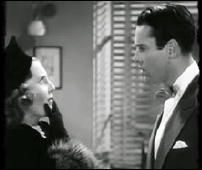
Murder to one side, there isn’t a serious bone in the film’s body, but it is a fast moving, bright and smart entry in the screwball heiress stakes and never pauses long enough to let you complain.
Philip G. Epstein co-wrote Casablanca and his other screen credits include Mr. Skeffington, The Man Who Came to Dinner, The Strawberry Blonde, and Arsenic and Old Lace.
The original screen story is from Wilson Collison, who among other things created Maisie, the heroine of the long running Ann Sothern film series, in his novel Dark Dame (1935). Leigh Jason directed many films and later television including Richard Diamond with David Jansen.
Fast paced and wickedly clever, with a cast of stars all shining and hitting their marks, you may find yourself enjoying this much more than it merits, but by any standard it is an entertaining outing that is a model of the form.
Watching directors struggle and fail today to produce this kind of clever film you have to wonder at the casual magic these films once produced. Like a good dessert champagne, this tickles your palates and lightens your mood, which is exactly what it was intended for.
